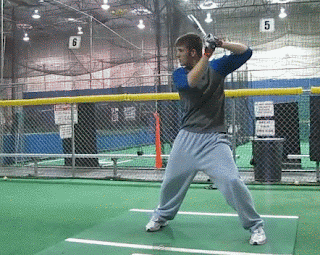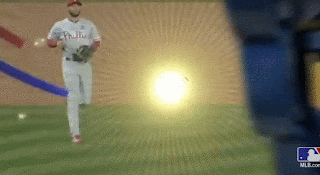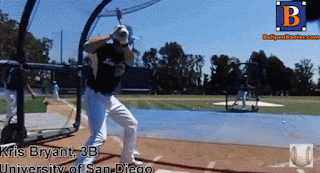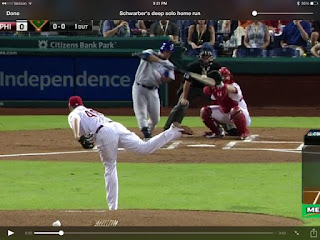If you haven't read Bobby's Ebook yet the link is above. One of the best ebooks I have read and I strongly suggest studying it.
Thursday, December 31, 2015
The Cage
As a hitter you want fast twitch muscles and you need to train and develop those fast twitch muscles. You can only train those muscles if you are swinging at close to 100%. Find out how hard you can swing and still be accurate with the barrel. This varies between hitters based on coordination and body type. Some like Javier Baez or Josh Donaldson can swing at close to 100% where a guy like Adrian Gonzalez swings near 80%. Find your ideal swing effort and you can only find that if you allow your body to swing at 100% and then work down from there.
Remember that anyone can hit off the tee or front flips or bp and make contact on the barrel. You can separate yourself if you develop that ability to be accurate while also swinging close to as hard as you can. As you take ownership of your swing understand that your swing will evolve into a dynamic swing if you have good focus in the cage on each rep and you are determined to push the limit with the amount of bat speed you can create.
Here are a few points of emphasis as you experiment with this concept:
1)be slower/earlier with your load so that your body has time to be dynamic during the load prior to landing.
2) Don't worry about the results of an individual rep. Don't be afraid to look bad in the cage as you experiment. You will never get a hit in the cage but you can become a great hitter in the cage. Evaluate your progress and focus, not the results
3) In the off season there is always something new to experiment with and fine tune. Be willing to experiment and work on different parts of your swing. You should never have a day in the off season where you are just taking mindless swings to "get your work in"
4)Swing hard and keep trying to be faster. You can never have too much bat speed.
5) Remember why you are in the cage: your goal should be to prepare to mash baseballs in the game. Kenny Powers has a ridiculous quote in Eastbound and Down when he said, "I play real sports, I'm not trying to be the best at exercising" The point relates to the topic today, "You want to rake in the game, you're not trying to be the best at hitting off the tee or taking flips or bp in the cage."
6) The test will be when you get around your teammates, the most discipline hitters create the same focus on getting better when they are in a small group as they do when they are at practice with the whole team. Your teammates opinion of your swing ability in the cage should be irrelevant to what you are working on. This is way easier to say then do but as I said above continue to remind yourself of your goals and what you are trying to accomplish in the games this spring and that will help you keep perspective and focus in your daily work.
Below is a few gifs of big leaguers working on the swing they want to take into the game during practice.
Monday, December 28, 2015
Presence and Confidence
I added two more great examples of expressing your dominance on the field without saying a word.
Saturday, December 26, 2015
Keep the Ball off the Ground
Hit hard line drives and fly balls. The opposite is taught at the high school and college level. "Put the ball in play" "Put pressure on the defense" "Just make contact" A weak ground ball is praised and a strike out is shunned. A lot of big league pitchers make a living as a pitch to contact, ground ball specialist. When you hit the ball on the ground with a man on first it can turn into a double play. With a man on third and less then two outs a ball in the outfield alway works. At the high school and college level the best defenders usually play in the infield. Get the ball in the outfield. There are only 3 guys out there and way more room for balls to land safely. This mindset also creates good "swing path" and allows the hitter to let the ball travel more. (will go into the mechanical advantages of this mentality in the next post)
In Ted Williams' book "the Science of Hitting" he says, "hit the ball hard and hit it in the air" He also talks about a slight uppercut swing as the ideal swing to match plane with a ball coming from an elevated mound. Kris Bryant, the National League rookie of the year made a similar quote, " “I liked hitting home runs when I was little,” Kris said. “To do that, you have to hit the ball in the air, so that’s why I caught on pretty quick to the idea of hit it high and hard. When I got to high school and college, where you begin learning about angles and stuff, it started to get easier. But I have always had that swing, in terms of a slight uppercut, so I guess I got it pretty young.” (I will talk about those angles in a future post)
In Kris Bryant's senior season at University of San Diego he hit 31 home runs; which was more than 221 Division 1 baseball teams hit for the entire 2013 season. Kris Bryant is 6'5'' but I believe height is irrelevant to power. Hank Aaron was 6 feet tall and Willie Mays was 5'11''. Power comes down to swing path, timing and seeing the ball well. Kris Bryant says, " I need to do what I need to do to be on time and see the ball as clearly as possible."
My last few posts have been about getting to a lower position to swing from. Being in a lower sitting position at landing allows you to attack pitches with a slight uppercut because the swing does not have to be as steep to the slight upper cut as it would be from a higher landing position. In the two clips below focus on his shoulders. The back shoulder goes down to the height of the pitch. The first two clips are balls up in the zone and the back shoulder still goes down. The last clips the ball is lower which adds more down in the back shoulder to contact. This movement creates a swing that has lift but doesn't make the swing long which is what many would say about the upper cut. Two final thoughts for today: 1) Work on this in the cage, once you are fully loose swing hard in the cage trying to hit hard high line drives. Most hitters never find out how hard they can swing and still be accurate with their barrel. 2) Even in the cage swing at balls you can hit on the barrel and drive to the outfield and lay off of pitches tossed/thrown to you that are above your belly button. Pitchers don't pitch above the top of the zone very often and when they do its by accident or a high waste fastball that should be a take. Pitchers try to throw both fastballs and off speed pitches down in the zone. Develop a swing where you can drive those pitches and also develop a swing that limits your ability to hit balls at your letters, its not a strike. As hitters until we get two strikes our goal is to only swing at balls we can drive to the outfield. The pitches we lay off of are just as important as the pitches we swing at. There are a lot of pitches that we make contact on in a game that if you had just taken that pitch on the corner you might of got the next pitch in the middle of the plate to drive. Saturday, December 19, 2015
The Sitting Action
The biggest problem that effects hitters is not getting themselves in a good position to adjust to the baseball. Timing is a key part of hitting but we have to understand that it is very difficult to have perfect timing. The key thing to understand is that if you have great body movements you don't have to be on time to still be in a good position to hit. Most hitters are taught that you load back and then you stride forward and the adjustments that hitting coaches make if that doesn't work is to "get the foot down early" or not stride at all. Neither of which helps the hitter store energy. Hitters need to think about the early movement in the swing as their element of style and timing. Some guys are loud with their load others are simple depending on body type and coordination levels. However, the "load" is not back and the stride is not forward. You need to decide how you are going to gather or load but all you are doing in the gather is setting yourself up for the down or sit. In the clips below you can see how the hitters are bringing their hip line down. Watch their back hip joint as it moves down. The reason that the stride is taught as a forward move is because the body does move forward as the hips or butt sits down. As you sit down your body naturally needs a wider base to support that position.
The main point of this post is to understand that you do not want to think of striding forward but instead sitting down or pushing your back hip down. The lower your start in your stance the less down there will be. Once we begin the sitting movement we just keep sitting down and track the ball and wait for it to get to us. Most hitters know that at contact the position of power is a bent back elbow however most amateur hitters get to contact with a straight back elbow. This is because most amateur hitters load back and stride forward so if they are not on time they have no way to adjust and have to reach out to hit the ball. (I put 3 pictures below of the right contact position)
This concept is difficult to put into words and I have done my best but here is an article that may help some understand it better: https://tewkshitting.com/josh-donaldson-swing-changes-over-time-and-adjusting-to-off-speed-pitches/
Watch Donaldsons' transformation as a hitter from college to pro ball and then look at how he adjusts to different pitches. I am going to stop there but continue to revisit this concept in future posts.

Wednesday, December 16, 2015
Landing position continued
 The biggest mechanical difference I notice with college players and MLB players is the position they put themselves in at landing. There are many mechanical advantages to being in the sitting position instead of being in the standing position that is common at the amateur level. The best way to feel this position is by over compensating in the cage and getting as low as possible at landing in the sitting position. In the next post I will try to explain in greater detail the advantages of getting to the sitting position that you see in the big leaguers above.
The biggest mechanical difference I notice with college players and MLB players is the position they put themselves in at landing. There are many mechanical advantages to being in the sitting position instead of being in the standing position that is common at the amateur level. The best way to feel this position is by over compensating in the cage and getting as low as possible at landing in the sitting position. In the next post I will try to explain in greater detail the advantages of getting to the sitting position that you see in the big leaguers above. Monday, October 26, 2015
The Low Pitch (The "uppercut swing")
The 3 frames below show how the body can work to attack the low pitch. In frame 2 you can see how the back shoulder is working down to the ball. The key is the front shoulder has not started to open . yet. Then in frame 3 which is prior to contact you can see the back shoulder start to work forward and the front shoulder opening up as rotation continues. The hands do not go straight down to the ball. I remember being told as a kid that an uppercut swing is wrong. On the low ball you want an upper cut swing. Try this in the cage this winter and sometimes your body starts to move into better mechanics if you think about having an uppercut swing on the low ball.
Wednesday, October 21, 2015
Adjustment to off speed
Chris' homerun he just hit in the ALCS is a great example of adjusting to an 0-2 change up the correct way. Most amateur hitters continue to move their body weight forward and lose all ability to use their lower half in the swing. Chris has awesome depth to his swing so he keep a strong bent back elbow as he just continues to rotate his back shoulder to the ball. The extension your see in the last frame is done well after the ball has made contact with the bat. You can see in the still frames below how Chris moves to contact and how at contact his back shoulder is more forward then it would be if he had perfect timing. Chris' back shoulder movements allow him to stay in the zone a long time and continue to be in a position of strength with his top arm.
The "Attacking Position"
The "attacking position" is a phrase I hear a lot when coaches talking about the ideal posture to swing from. I agree that it is important to get to a position at landing where the upper body hinges at the waist and the chest moves towards the plate. I've heard it called a crunch, getting to athletic position or creating room for the back elbow to work. This hitting posture needs to be created to some extent and the angle of the spine depends on the flexibility of the individual hitter. However pre setting the attacking posture in the stance creates pressure and tension in the lower back for most body types and I am a big advocate for creating the attacking position during the load or timing sequence of the swing. How early or late your begin to hinge at the waist and how much you move your chest towards home plate is up to each individual hitter and should be experimented with to find whats comfortable for your body. The main reason creating the attacking position is important is as you hinge at the waist and lower your chest to home plate you are getting your back shoulder in a lower position to fire down into the strike zone when its time to swing. The farther your back shoulder is from home plate the farther it has to go to get into the hitting zone. The majority of the pitches that are thrown to hitters are down and we need to set up our body and our eyes in a position to be accurate and on plane for those pitches. In the next post I will talk about the front shoulder's movements in the swing.
Tuesday, October 20, 2015
Below is Bour's sequence of timing for a 3 run home run he hit earlier this year. Notice his timing compared to the pitcher's delivery. His timing mechanism and barrel tip happens later then you would think. Notice where the ball is in picture 3 as he finishes tipping his barrel. The baseball is out of the pitchers hand. In picture 4 you can see the turn of the elbow and back shoulder which initiates the actual swing. In picture 4 and 5 you can see the top arm's elbow and shoulder work down and stay tight to the body, then in picture 6 you can see the top elbow move slightly away from the body as Bour adjusts to a pitch on the outside half of the plate, if the pitch was inside you would see the elbow stay closer to the body. His timing is not perfect on this pitch but he creates "bat path" for himself by in picture 4 taking his back shoulder down and to the ball. If Bour had just taken his knob to the ball he would most likely have rolled over this pitch for a ground ball out to the right side. The swing does not happen in straight lines back to front even though the swing is taught that way by a lot of people. Extension is irrelevant. Work on getting into the right movement patterns that allow you to be in the proper position at contact. What happens after contact is just a byproduct of timing, pitch and pitch location.
Subscribe to:
Comments (Atom)






















































